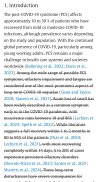Functional olfactory impairment and fatigue in post-COVID-19 syndrome including ME/CFS – a longitudinal prospective observational study
Lil Meyer-Arndt, Greta Pierchalla, Lukas Mödl, Felix Wohlrab, Franziska Legler, Uta Hoppmann, Claudia Kedor, Kirsten Wittke, Helma Freitag, Frank Konietschke, Heidi Olze, Friedemann Paul, Carmen Scheibenbogen, Judith Bellmann-Strobl, Ulrike Förster-Ruhrmann
Highlights
• Olfactory function improved after 20 months post-COVID-19 infection.
• Odor identification did not significantly improve within 28 months.
• Olfactory function and fatigue seem to be independent processes in PCS.
• Early olfactory improvement is linked to better long-term cognitive outcomes.
Abstract
Post-COVID-19 syndrome (PCS) affects a significant proportion of individuals, with olfactory impairment and fatigue as prominent long-term symptoms. A subset of PCS patients with pronounced fatigue meets the diagnostic criteria for myalgic encephalomyelitis/chronic fatigue syndrome (ME/CFS), here referred to as PCS-ME/CFS. This study explores the relationship between PCS, fatigue, and olfactory function, and investigates the potential of olfactory impairment as a diagnostic and prognostic marker.
We assessed olfactory function up to 28 months post-COVID-19 in 45 PCS patients (22 PCS, 23 PCS-ME/CFS) using the extended Sniffin’ Sticks test, which evaluates odor threshold, discrimination, and identification, providing a composite score. Fatigue severity and health-related quality of life were assessed using validated questionnaires, a standardized test measured cognitive function, and handgrip strength indicated physical fatiguability.
Both PCS and PCS-ME/CFS patients showed significant improvement in olfactory function, with all patients returning to normosmia after 20 months, regardless of diagnosis. While odor threshold was the most affected olfactory measure in Sniffin’ Sticks testing, odor identification was the only measure that remained impaired over time. Olfactory impairment correlated with cognitive, physical, and mental performance, with stronger correlations in the PCS group, particularly linking better odor discrimination at baseline to improved daily functioning and health-related quality of life after 20 months.
Our findings suggest that odor identification assessed in standardized testing may remain impaired the longest in patients with persisting symptoms after COVID-19, reflecting persisting central processing difficulties. Correlations between olfactory performance, cognitive function, and physical ability point to shared underlying mechanisms. Early olfactory improvements may be linked to better long-term cognitive outcomes, highlighting a possible prognostic role of olfactory function in these patients.
Web | PDF | Brain, Behavior, & Immunity - Health | Open Access
Lil Meyer-Arndt, Greta Pierchalla, Lukas Mödl, Felix Wohlrab, Franziska Legler, Uta Hoppmann, Claudia Kedor, Kirsten Wittke, Helma Freitag, Frank Konietschke, Heidi Olze, Friedemann Paul, Carmen Scheibenbogen, Judith Bellmann-Strobl, Ulrike Förster-Ruhrmann
Highlights
• Olfactory function improved after 20 months post-COVID-19 infection.
• Odor identification did not significantly improve within 28 months.
• Olfactory function and fatigue seem to be independent processes in PCS.
• Early olfactory improvement is linked to better long-term cognitive outcomes.
Abstract
Post-COVID-19 syndrome (PCS) affects a significant proportion of individuals, with olfactory impairment and fatigue as prominent long-term symptoms. A subset of PCS patients with pronounced fatigue meets the diagnostic criteria for myalgic encephalomyelitis/chronic fatigue syndrome (ME/CFS), here referred to as PCS-ME/CFS. This study explores the relationship between PCS, fatigue, and olfactory function, and investigates the potential of olfactory impairment as a diagnostic and prognostic marker.
We assessed olfactory function up to 28 months post-COVID-19 in 45 PCS patients (22 PCS, 23 PCS-ME/CFS) using the extended Sniffin’ Sticks test, which evaluates odor threshold, discrimination, and identification, providing a composite score. Fatigue severity and health-related quality of life were assessed using validated questionnaires, a standardized test measured cognitive function, and handgrip strength indicated physical fatiguability.
Both PCS and PCS-ME/CFS patients showed significant improvement in olfactory function, with all patients returning to normosmia after 20 months, regardless of diagnosis. While odor threshold was the most affected olfactory measure in Sniffin’ Sticks testing, odor identification was the only measure that remained impaired over time. Olfactory impairment correlated with cognitive, physical, and mental performance, with stronger correlations in the PCS group, particularly linking better odor discrimination at baseline to improved daily functioning and health-related quality of life after 20 months.
Our findings suggest that odor identification assessed in standardized testing may remain impaired the longest in patients with persisting symptoms after COVID-19, reflecting persisting central processing difficulties. Correlations between olfactory performance, cognitive function, and physical ability point to shared underlying mechanisms. Early olfactory improvements may be linked to better long-term cognitive outcomes, highlighting a possible prognostic role of olfactory function in these patients.
Web | PDF | Brain, Behavior, & Immunity - Health | Open Access

